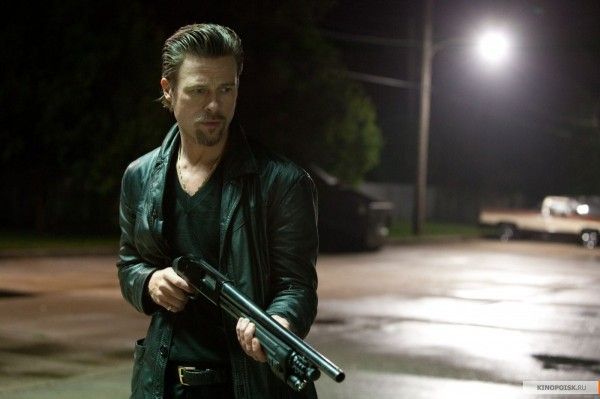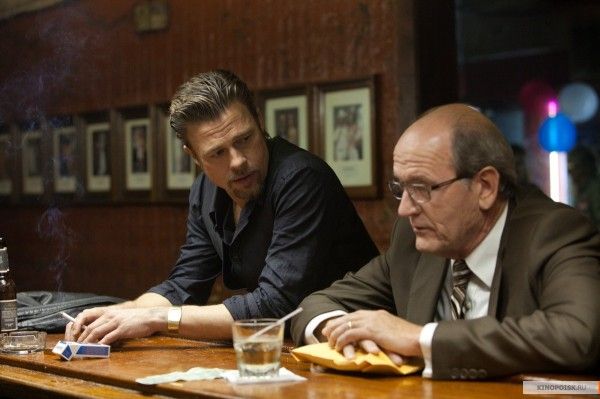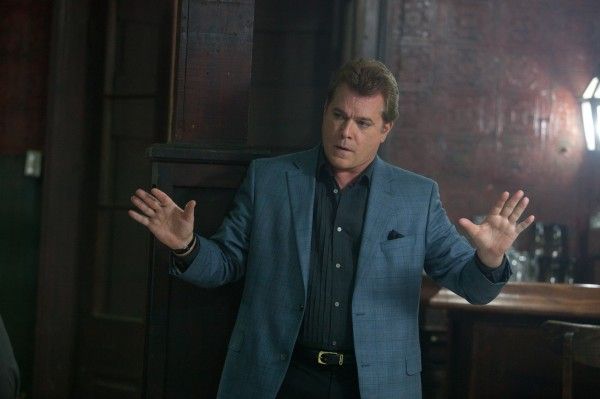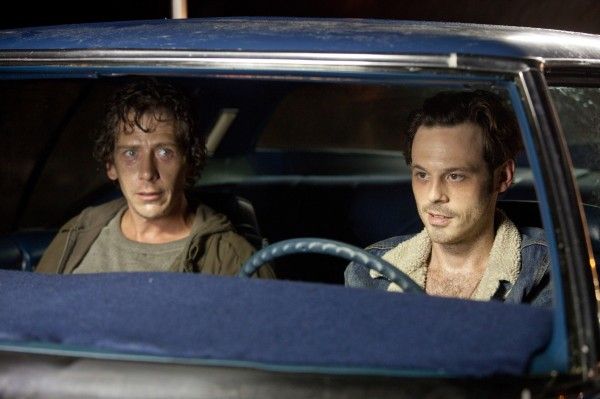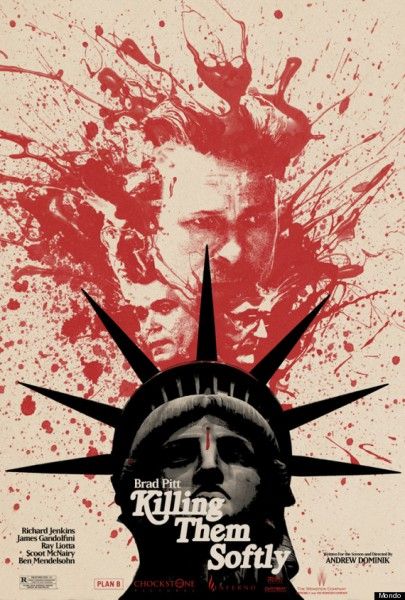The gangster drama Killing Them Softly, adapted from the George V. Higgins novel Cogan’s Trade, tells the story of Frankie (Scott McNairy), a broke young crook who’s fresh out of jail, and Russell (Ben Mendelsohn), an Australian junkie who makes a living stealing dogs, who are recruited to steal from a mob-protected card game that’s run by Markie (Ray Liotta). But, even though their plan seems foolproof, the mob feels otherwise and brings in seasoned enforcer Jackie Cogan (Brad Pitt) to send a message. From writer/director Andrew Dominik (The Assassination of Jesse James by the Coward Robert Ford), the film also stars James Gandolfini, Richard Jenkins, Sam Shepard and Vincent Curatola.
During this recent exclusive phone interview with Collider, filmmaker Andrew Dominik talked about what he most connected with in this story, how he approached adapting it for the screen, why he wanted Brad Pitt for the film, how easy this impressive cast was to assemble, his approach to the violence, deleted scenes, the test screening process, and film versus digital. He also talked about his desire to make Blonde, about the life of Marilyn Monroe, his next film with Naomi Watts in the lead role. Check out what he had to say after the jump.
Collider: What did you most connect with in Cogan’s Trade that made you want to turn it into a film?
ANDREW DOMINIK: I think it was the characters and the confusion they all seem to feel about various things. The movie is about a loss of vitality. That was the vibe that I got from it. Also, I found it incredibly entertaining, but at the same time, it was true. That was the main attracted. And then, it had a very simple plot and I realized, at the time, that it was a microcosm of what was going on in the larger world. It was the story of an economic crisis. And I started to see a way to make a movie that was almost like a political cartoon. There was a real work-a-day aspect to it, with this idea that crime is a drag. Everything is a drag for these characters.
When you were adapting the book for the screen, did you approach it with an open mind, as far as things you could and needed to change?
DOMINIK: I probably didn’t follow conventional wisdom too much, in terms of that. There are schools of thought about that. Some people feel like you should show things rather than have people say things, and you need to start dramatizing things rather than have people talk about them. And then, there are others who want to keep the claustrophobia of something. What attracted me to it was, essentially, the dialogue. These were a bunch of really verbose people that had a lot to say about their lives and about the world that they lived in, and I really liked all that stuff. I’m from the “if it ain’t broke, don’t fix it” school of screenwriting. I just like to preserve what works and ignore what doesn’t work.
Had you immediately thought of Brad Pitt for this, or did that come out of the process of writing the screenplay?
DOMINIK: No, Brad was involved before I even started writing the screenplay. I thought of him instantly, when I read it. You obviously can’t cast Brad as an everyman guy because he just brings way too much baggage to something like that. But, if he’s playing a mythological character or somebody exceptional than his baggage is a good thing. And he’s a great actor. I love working with Brad. We’ve developed a relationship where we can trust each other, so he’s always the first port of call for me.
When you have dialogue that’s this strong, did you find it pretty easy to assemble the impressive cast of actors that you have?
DOMINIK: It was easy, surprisingly. Part of it was also that Brad was doing it. Most actors really respect him, as an actor, and they want to work with him, but we were really lucky. We offered the part to Richard Jenkins, and he turned us down. He actually called back the next day and said, “You know what? I read it again and I actually think it’s good. I’m going to do it.” I remember (producer) Dede [Gardner] and I looking at each other, at one point, and going, “Geez, this never happens. Everyone we’ve gone to and offered a part has said yes. Maybe we should call Daniel Day-Lewis.” But, we didn’t. It was certainly easier than it usually is.
People like James Gandolfini and Ray Liotta are known for being in this type of film, but they’re playing very different versions of what you’re used to seeing them as. Did you intentionally cast people against convention?
DOMINIK: It’s funny that you say that because I was kind of typecasting. I wanted to look at it like an old screwball comedy where you cast cartoon-ish types, like the fat guy and the skinny guy and the sweaty Australian guy and the tough guys. I wanted them to be instantly easy to recognize, so that the audience could work out who is who. I guess I got the best of both worlds because, by casting guys like Ray and Jim, and then having them not fulfill or confound your expectations, seemed to really work for us as well.
Had you ever considered making the violence more subtle, or had you always wanted to go for that really brutal approach to it?
DOMINIK: One of the key things going on in the movie is this idea that people are doing everything they can to avoid violence or avoid getting their hands dirty, and I wanted you to be able to really understand why. Obviously, the way to do that is to make violence really unappealing. It always surprises me in films that killers seem so gleeful about killing people. I imagine that in a closed, hermetic society like the mob, where everybody knows each other, it must be really, really unpleasant to have to kill people. It’s the sort of thing you really want to avoid. So, I decided to play up that angle a little bit, for laughs. I like violence to be upsetting. The only reason to do it subtley is if doing it subtley makes it more effective somehow.
Did you want to make sure that these characters were sympathetic?
DOMINIK: Well, I certainly felt sympathetic towards them all. They all felt like different aspects of myself, in some way. I could put myself in the shoes of each person. I definitely was deliberately trying for that. I’m always surprised when people say, “Oh, I don’t like these people.” They just seem like normal people to me, just in more extreme circumstances.
How long was your first cut of the film, and are there a lot of deleted scenes that could end up on the DVD?
DOMINIK: There’s a few that could end up there. Most of the things that got cut, got cut for a reason. With a movie like this, that is wall-to-wall dialogue, there was a lot more dialogue. My approach is that I always go out with a prayer. This is the screenplay that I want to do, and certain things are going to work better than other things, so there’s a certain amount of wastage. The first cut was probably about two and a half hours, or something like that, and then it gradually gets widdled down. You’ve got a movie that’s not terribly plot driven, but at the same time, it’s gotta keep moving forward. If you cut it down to just what moves the story forward, you’re going to end up with not much. But at the same time, you can’t let it completely turn into character soup. It’s balancing that stuff that’s the trick.
Do you still have a lot of deleted scenes from The Assassination of Jesse James by the Coward Robert Ford, that have never been released?
DOMINIK: Jesse James is something where I think it would be worthwhile to release another cut or two of the movie. I personally think that. Unfortunately, the movie just didn’t set the world on fire enough to justify it. Maybe Warner Bros. would be interested in doing it. If they did, I would be right into it.
What are your thoughts on the test screening process?
DOMINIK: I like test screenings. I like to see a movie with an audience of strangers. I think it tells you a lot. It’s very difficult to lie to yourself about certain things. I’m not necessarily convinced about how information is gathered and I don’t think the credence that’s given to it is valid. When you ask a bunch of people to see a film, and then invite them to comment on it and tell them it’s a work-in-progress, they feel bound to offer an opinion. Also, the kind of people who go to test screenings are people that have time to go see a free movie. What they object to is anything that’s unusual about a film. Anything that’s memorable about a movie is often what a test audience will object to because they’re being asked to be experts. They just compare the film they finished watching to all of the other films that they’ve seen. Films that score very high with test audiences generally tend to not be so great. But, there’s a lot of money involved in making movies and it’s a way for people to reassure themselves, who have spent money, and it’s also a way to work out how to market a movie. It’s also a way to really clear up confusions in a film. That’s important. As a filmmaker, it’s important to sit there and feel embarrassed. If you feel embarrassed by something, you cut it.
Is the Marilyn Monroe film Blonde the next thing you’re hoping to start production on?
DOMINIK: That’s the one I want to do. Yeah, definitely. I’m working on that.
What are the challenges, as a filmmaker, in wanting to tell a story like that, that spans her lifetime?
DOMINIK: I don’t know. She died when she was 36, so you probably need someone in their late 20's to do the part. There’s a huge chunk when she’s seven, and then the rest of it would all be another actor, who’s the main actor.
And you’re hoping that will be Naomi Watts?
DOMINIK: At this stage, yeah.
What is your preference for film versus digital, and why?
DOMINIK: Well, I don’t like digital. It keeps getting better and better, and it looks like it’s eventually going to just overwhelm film. I guess, in the end, it’s really about the people on the screen rather than the delivery method. All movies are starting to look the same, which is a shame. There’s something about having to wait for dailies. I’ve never shot digital, so I don’t know. For me, my favorite film stocks were the ones in the late ‘80s. They’ve improved film stocks to the point where you can go seven stops over and five stops under. It’s a nightmare, if you want to blow the windows out or get a decent highlight. At film school, we shot on reversal, which has a one and a half stop latitude. You really had to expose things correctly. There was something magical about doing it that way, which I feel has fallen by the wayside.
Are you the type of filmmaker that likes to have multiple projects in various stages of development, or do you prefer to focus on one thing at a time?
DOMINIK: I’m not a multi-tasker. I’m pretty much a one at a time type of guy. Other people are probably a little more sensible, in that they just want to work. I find that it’s like being in love with more than one person at once. That would be hard for me.
Everyone who works with you talks about how they love the experience because of the passion you have for movie-making. Where did that passion come from? Is it just something you’ve always wanted to do?
DOMINIK: Yeah. I just loved films. I really did. I loved going to the movies. It seemed so magical that you could just disappear into this other world for two hours. The idea of being able to make them was just really attractive.
Killing Them Softly opens in theaters on November 30th.

